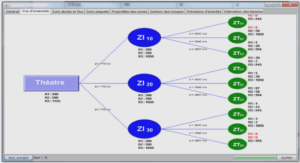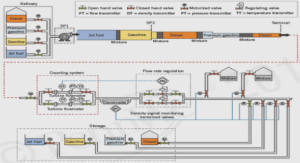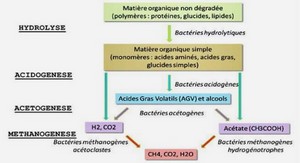Uncoupled KdV approximation
Derivation of the approximation
Let us recall the expression of (Σ) : (Σ) (1 − εa2∂ 2 x )∂tv + ∂xη + ε h 1 2 η∂xη + 3 2 v∂xv − 1 2 b∂xη + a1∂ 3 xη i = 0 , (1 − εa4∂ 2 x )∂tη + ∂xv + ε h 1 2 ∂x ((η − b)v) + a3∂ 3 x v i = 0 , with a2 ≥ 0 and a4 ≥ 0. We point out that that such a system is well posed for sufficiently smooth initial data and provides an approximation of the water waves problem of order O(ε) for times of order O(1/ε) (see Part I and [3] for further details). In order to recover the KdV approximation, we first diagonalize (Σ) by introducing the following unknowns : U = v + η ; N = v − η 55 uncoupled KdV approximation 56 4. THE UNCOUPLED KDV APPROXIMATION Pluging the relations v = U + N 2 and η = U − N 2 into (Σ) yields the following coupled system (Γ) in terms of U and N : (Γ) ∂tU + ∂xU + ε · 1 8 ∂x(3U 2 + N 2 + 2UN) − 1 2 b∂xU − 1 4 ∂xb(U + N) − a2 2 ∂ 2 x∂t(U + N) − a4 2 ∂ 2 x∂t(U − N) + a1∂ 3 xU i = 0 , ∂tN − ∂xN + ε · 1 8 ∂x(U 2 + 3N 2 + 2UN) + 1 2 b∂xN + 1 4 ∂xb(U + N) − a2 2 ∂ 2 x∂t(U + N) + a4 2 ∂ 2 x∂t(U − N) − a1∂ 3 xN i = 0 . At this step, we choose to look for approximate solutions (Uapp, Napp) of (Γ) of the form : Uapp(t, x) = U0(T, x − t) + εU1(T, t, x) , Napp(t, x) = N0(T, x + t) + εN1(T, t, x) , (4.1.1) where T is the slow time variable T = εt. The use of two different time scales is useful in capturing both the short time evolution of the wave and the nonlinear and dispersive dynamics which occur for larger time scales. We complement this ansatz with two initial conditions on (Uapp, Napp) and a classical sublinear growth condition on the correctors (U1, N1) : Uapp |t=0 = U|t=0 ; Napp |t=0 = N|t=0 , and for all T0 ≥ 0 lim t→+∞ 1 t |U1(. , t, .)|L∞([0,T0];L2(R)) = 0 , lim t→+∞ 1 t | N1(. , t, .)|L∞([0,T0];L2(R)) = 0 . (4.1.2) Such a condition on the correctors is quite usual in multiscales expansions and has been first introduced in the context of nonlinear geometric optics by Joly, Métivier and Rauch in [34]. It forces the correctors εU1 and εN1 to be small on the large time scale associated to the KdV dynamics ; namely, it ensures that εU1 = o(1) and εN1 = o(1) in L ∞([0, T0 ε ];L 2 (R)). Pluging this ansatz into (Γ) and neglecting the terms of order O(ε) yields the following system : (∂t + ∂x)U1 = f(T, x − t) − 1 8 ∂xN 2 0 − 1 4 ∂x(U0N0) + 1 2 b∂xU0 + 1 4 U0∂xb + 1 4 N0∂xb + a2 − a4 2 ∂ 3 xN0 , (∂t − ∂x)N1 = g(T, x + t) − 1 8 ∂xU 2 0 − 1 4 ∂x(U0N0) − 1 2 b∂xN0 − 1 4 U0∂xb − 1 4 N0∂xb − a2 − a4 2 ∂ 3 xU0 , (4.1.3) 4.1. Derivation of the approximation 57 where f(T, x − t) = −∂TU0 − 3 8 ∂xU 2 0 − (a1 + a2 + a4 2 ) ∂ 3 xU0 , g(T, x + t) = −∂T N0 − 3 8 ∂xN 2 0 + (a1 + a2 + a4 2 ) ∂ 3 xN0 . (4.1.4) N.B. : For the sake of simplicity and readability, we have kept here the notations ∂x on U0 and N0 while we should have written rigorously ∂X− U0 and ∂X+ N0 with X− = x − t and X+ = x + t. At this step, an explicit resolution of (4.1.3) in terms of U0 and N0 shows that U1 and N1 have the simplified form : ( U1(T, t, x) = t × f(T, x − t) + h 1 b (U0(T, x − t), N0(T, x + t)) , N1(T, t, x) = t × g(T, x + t) + h 2 b (U0(T, x − t), N0(T, x + t)) , the complete expression of (U1, N1) being given at the end of this chapter in (4.2.2). Such expressions of U1 and N1 include terms that grow linearly in time, which is inconsistent with the sublinear growth conditions (4.1.2). It follows that both f(T, x − t) and g(T, x − t) must be null quantities for all (T, t, x) ∈ [0, T0] × R 2 . Writing explicitly this result, remarking that a1+(a2+a4)/2 = (a1+a3+a2+a4)/2 = 1/6 and pluging it into (4.1.3), one obtains the following uncoupled KdV equations on (U0, N0) and inhomogeneous transport equations on the correctors (U1, N1) : (ΣKdV ) ∂TU0 + 3 8 ∂xU 2 0 + 1 6 ∂ 3 xU0 = 0 , ∂T N0 + 3 8 ∂xN 2 0 − 1 6 ∂ 3 xN0 = 0 , (4.1.5) and (Σcorr) (∂t + ∂x)U1 = − 1 8 ∂xN 2 0 − 1 4 ∂x(U0N0) + 1 2 b∂xU0 + 1 4 U0∂xb + 1 4 N0∂xb + a2 − a4 2 ∂ 3 xN0 , (∂t − ∂x)N1 = − 1 8 ∂xU 2 0 − 1 4 ∂x(U0N0) − 1 2 b∂xN0 − 1 4 U0∂xb − 1 4 N0∂xb − a2 − a4 2 ∂ 3 xU0 . (4.1.6) Finally, we can construct an approximation of the solutions of the initial system (Σ) in a natural way : let (v ε Σ, η ε Σ)0≤ε≤ε0 be a family of solutions of (Σ) with initial data (v0, η0). One defines u0 = v0 + η0 and n0 = v0 − η0, and let (U0, N0) be the solutions of the uncoupled KdV equations (ΣKdV ) with initial data (u0, n0). In the end, the uncoupled KdV approximation of the solutions of (Σ) is given by : (M) : v ε KdV = U0 + N0 2 ; η ε KdV = U0 − N0 2 . (4.1.7) This approximation corresponds to the one proposed by Schneider-Wayne for flat bottoms and by Iguchi for uneven bottoms.
Validity of the approximation for sufficiently decaying topographies
Recalling that (Uapp, Napp) are given by (4.1.1), we now introduce the following quantities : v ε app = Uapp + Napp 2 ; η ε app = Uapp − Napp 2 . (4.2.1) in order to prove the following proposition. Proposition 4.2.1. Let s ≥ 2, σ ≥ s + 5, (v0, η0) ∈ Hσ (R) and b ∈ W1,∞(R). Let (v ε Σ, η ε Σ)0≤ε≤ε0 be a family of solutions of (Σ) with initial data (v0, η0). We define (u0, n0) = (v0 + η0, v0 − η0). Then there exists a unique solution (U0, N0) to the system (ΣKdV ) with initial data (u0, n0) and this solution is bounded in L ∞([0, T0]; Hσ (R)). Moreover, we have the following error estimate for all t ∈ [0, T0 ε ] : ¯ ¯ ¯(v ε Σ, η ε Σ) − (v ε app, η ε app) ¯ ¯ ¯ L∞([0,t];Hs(R)) ≤ C |(U1, N1)|L∞([0,T0]×[0,t];Hs+3(R)) ε 2 t , where (v ε app, η ε app) is defined in (4.2.1). Proof. The result on the system (ΣKdV ) is a very classical result on the KdV equation and we omit the proof here. The leading terms (U0, N0) and the correcting terms (U1, N1) have been chosen such that (Uapp, Napp) is solution of the system (Γ) with a residual of order O(ε 2 ). This residual denoted by (ε 2R1, ε2R2) can be computed explicitly and we get : R1 = − 3 4 ∂x(U0U1) − 1 4 ∂x(N0N1) − 1 4 ∂x(U0N1) − 1 4 ∂x(U1N0) + 1 2 b∂xU1 + 1 4 (U1 + N1)∂xb − a1∂ 3 xU1 + a2 + a4 2 ∂ 2 x∂tU1 + a2 − a4 2 ∂ 2 x∂tN1 + a2 + a4 2 ∂ 2 x∂TU0 + a2 − a4 2 ∂ 2 x∂T N0 + ε · 3 8 ∂xU 2 1 + 1 8 ∂xN 2 1 + 1 4 ∂x(U1N1) ¸ . with a similar expression holding for the residual R2 of the second equation of (Γ). Using the equations (ΣKdV ) and (Σcorr) to express ∂TU0, ∂T N0, ∂tU1, ∂tN1 in terms of spatial derivatives of U0, N0, U1, N1 and using the fact that s ≥ 2, this expression yields easily for all t ∈ [0, T0 ε ] : |(R1, R2)|L∞([0,t];Hs(R)) ≤ C |(U1, N1)|L∞([0,T0]×[0,t];Hs+3(R)) , with C depending only on |(U0, N0)|L∞([0,T0];Hs+3(R)) and |b|W1,∞(R) . Inverting the diagonalization by pluging the relations Uapp = vapp + ηapp and Napp = vapp − ηapp into (Γ), we easily deduce that (v ε app, η ε app) is solution of the system (Σ) with a residual bounded by Cε2 |(U1, N1)|L∞([0,T0]×[0,t];Hs+3(R)). Standard energy estimates applied on the symmetric Boussinesq system (Σ) yield easily : |(v ε Σ, η ε Σ) − (v ε app, η ε app)|L∞([0,t];Hs+3(R)) ≤ C |(U1, N1)|L∞([0,T0]×[0,t];Hs(R)) ε 2 t , which ends the proof. An easy extension of this proposition is the following corollary which gives an error bound for the KdV approximation. Corollary 4.2.2. Under the same hypothesis as in Proposition 4.2.1, we have the following error estimate for all t ∈ [0, T0 ε ] : ¯ ¯ ¯(v ε Σ, η ε Σ) − (v ε KdV , η ε KdV ) ¯ ¯ ¯ L∞([0,t];Hs(R)) ≤ C |(U1, N1)|L∞([0,T0]×[0,t];Hs+3(R)) ε(1 + εt), where (v ε KdV , η ε KdV ) is the uncoupled KdV approximation defined in (4.1.7). Proof. One has : (v ε Σ, η ε Σ) − (v ε KdV , η ε KdV ) = (v ε Σ, η ε Σ) − (v ε app, η ε app) + (v ε app, η ε app) − (v ε KdV , η ε KdV ) = (v ε Σ, η ε Σ) − (v ε app, η ε app) + ε ³U1 + N1 2 , U1 + N1 2 ´ Using this relation and the error estimate coming from Proposition 4.2.1 yields the result. This corollary clearly states that the validity of the uncoupled KdV approximation only depends on the control of the correcting terms (U1, N1) in L ∞ ³ [0, T0] × [0, t]; Hs+3(R) ´ norm on the large time scale 1/ε. From now on, these correctors become the center of our analysis. As we saw earlier, the inhomogeneous transport equations that govern the evolution of the correctors (U1, N1) can be solved explicitly in terms of U0 and N0. We thus get the following expression : U1(t, x) = − 1 16 (N 2 0 (x + t) − N 2 0 (x − t)) − a2 − a4 2 (∂ 2 xN0(x + t) −∂ 2 xN0(x − t)) − 1 8 U0(x − t)(N0(x + t) − N0(x − t)) + 1 4 U0(x − t)(b(x) − b(x − t)) − 1 4 ∂xU0(x − t) Z t 0 N0(x − t + 2s)ds + 1 2 ∂xU0(x − t) Z t 0 b(x − t + s)ds + 1 4 Z t 0 ∂xb(x − t + s)N0(x − t + 2s)ds , (4.2.2) 60 4. THE UNCOUPLED KDV APPROXIMATION and a similar expression holds for N1. We here only deal with the case of U1 since all the method can easily be adapted to the case of N1. The corrector U1 is analysed in the following way : let T0 ≥ 0, s ≥ 2, σ ≥ s+ 5 and (u0, n0) in Hσ (R). We know that the solutions (U0, N0) of the problem (ΣKdV ) with initial data (u0, n0) are bounded in L ∞([0, T0]; Hσ (R))2 . We suppose here that the bottom topography b is bounded in W1,∞(R). Under these circumstances, it clearly appears that the first four terms of the expression of U1 are bounded in L ∞([0, T0] × [0, t]; Hs+3(R)). Only the last four terms can be problematic and deserve a precise treatment. If (U0, N0) and b come with a sufficient decay rate at infinity, we can straightforwardly control these terms. To this end and following [62], we introduce the following weighted Sobolev space Hs,α for all s ∈ N and α ∈ R : Hs,α = n u ∈ Hs (R) / |u| 2 Hs,α ≡ Xs k=0 ¯ ¯ ¯(1 + x 2 ) α/2 ∂ ku ∂xk ¯ ¯ ¯ L2(R) < ∞ o We can now state our first theorem on the validity of the approximation for sufficiently decaying initial data and bottom topography. Theorem 4.2.3. Let s ≥ 2, σ ≥ s + 5, (v0, η0) ∈ Hσ,1 (R) 2 and b ∈ Hs+4,1 (R). Let (v ε Σ, η ε Σ)0≤ε≤ε0 be a family of solutions of (Σ) with initial data (v0, η0). We define (u0, n0) = (v0+η0, v0−η0). Then the solution (U0, N0) of the system (ΣKdV ) with initial data (u0, n0) is bounded in L ∞([0, T0]; Hσ,1 (R)). Moreover, we have the following error estimate for all t ∈ [0, T0 ε ] : ¯ ¯ ¯(v ε Σ, η ε Σ) − (v ε KdV , η ε KdV ) ¯ ¯ ¯ L∞([0,t];Hs(R)) ≤ Cε(1 + εt), where (v ε KdV , η ε KdV ) is the uncoupled KdV approximation defined in (4.1.7). Proof. We know from [37] and [62] that the KdV equation propagates the regularity of initial data taken in weighted Sobolev spaces and we omit the proof here. The end of the proof is devoted to the estimate of |(U1, N1)|L∞([0,T0]×[0,t];Hs+3(R])2 . The work of Lannes in [42] is here very useful to control this quantity. Indeed, using the equations (Σcorr), the fact that U0(T, .), N0(T, .) and b are bounded in Hσ,1 (R), and Proposition 3.5 of [42], one finally obtains the estimate : |(U1, N1)|L∞([0,T0]×[0,t];Hs+3(R])2 ≤ C(|b|Hσ,1(R) ,(U0, N0)L∞([0,t];Hσ,1(R))2 ) . Pluging this last estimate into the result of Proposition 2.2 ends the proof.





